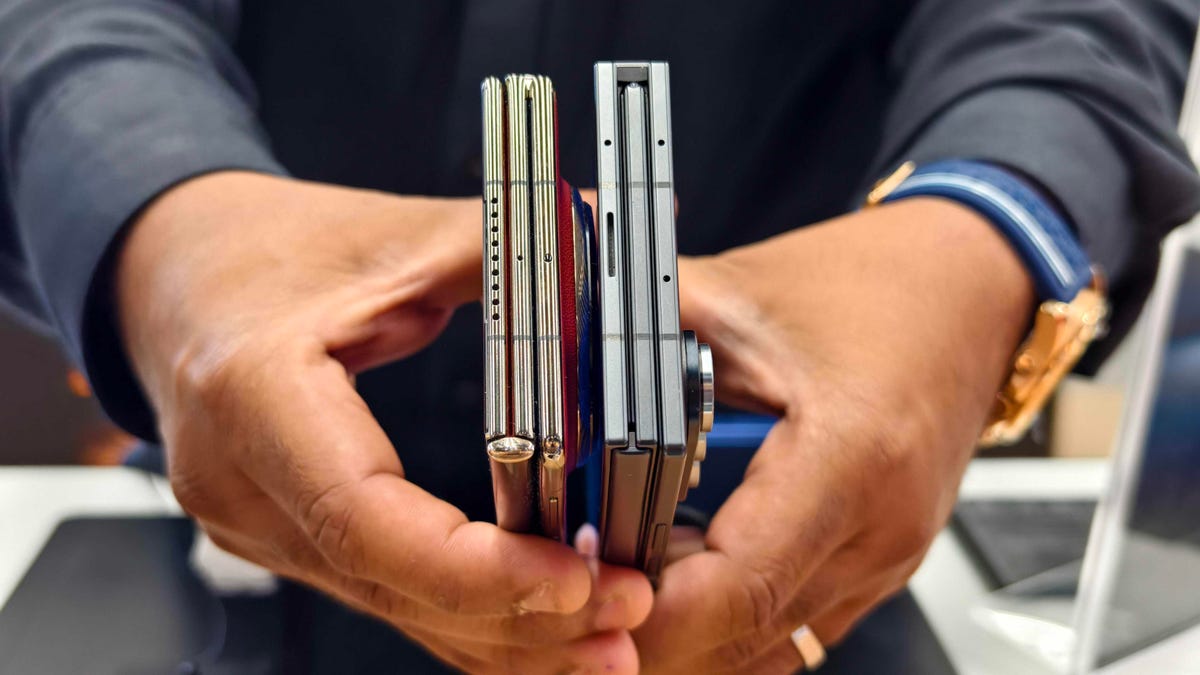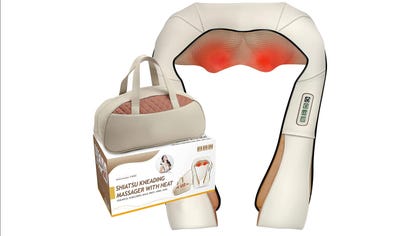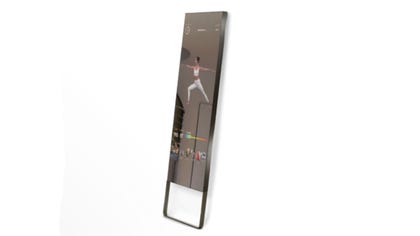Technologies
2022 Black Friday: Make Sure You Avoid All the Elaborate Scams
Scammers don’t take a break during the holidays. Learn what to watch for to protect yourself.

This story is part of Gift Guide, our year-round collection of the best gift ideas.
Black Friday arrives the day after Thanksgiving — which is Nov. 25 this year. It’ll be a day filled with deals on items like headphones and TVs, but with all that potential money flowing from customers to stores, cybercriminals are unfortunately looking to steal some of it.
Scammers work year round, but they turn up their efforts during the high-spending holiday season to exploit the spirit of giving.
The scams range far and wide — as retailers like Amazon, Best Buy and Walmart roll out deals over the holidays, fraudsters create elaborate websites to trick you into spending money on products you’ll never receive. You may receive text messages or emails claiming you’re eligible for a refund for an item you never purchased, just so thieves can get your credit card information. You might even be enticed into donating to a charity that provides homes for abandoned puppies — only to find out it doesn’t actually exist.
Scams come in all shapes and sizes, but there are always red flags to help spot them. Here’s what you need to know about Black Friday scams and how to avoid becoming a victim this holiday season.
For more about security and privacy this holiday season, check out how to protect yourself from identity theft, how to protect your phone app privacy, and the most common cryptocurrency scams.
Fake websites and fraudulent apps go ‘phishing’
In a phishing scheme, the goal is for hackers to get their hands on your personal information, like your credit card number, social security or account password. Pretending to be a large retail corporation, the fraudsters send out an official-looking email or text message, usually with a link to a fraudulent website designed to look just like a legitimate site.
Researchers at security firm Avanan discovered that hackers were sending out spoofed Amazon order notification emails. The email resembled your run-of-the-mill order confirmation, except that the order is false and the charge is significant.
Naturally, if you believe you’re being charged for a substantial amount, you would want to reach out to Amazon. But in this instance, if you use the link in the phishing email to get in contact, you’ll be redirected to a fake Amazon webpage with a false phone number to dial. If you call, the fraudsters won’t initially pick up, but they’ll soon call back, asking you to provide your card number, expiration date and CVV to «cancel the order.» And just like that, they’ve got your information.
These types of attacks are commonplace throughout the year, but expect a surge in messages claiming to be from Amazon, Best Buy, Walmart, Target or other large retailers during the holidays.
If you receive an email asking you to update your payment method or requesting other personal information, contact the company’s help desk to make sure the email is legit before you do anything else.
Other ways to identify a phishing email, according to the Federal Trade Commission and StaySafeOnline.org, include:
- The sender’s email address looks almost right but contains extra characters or misspellings.
- There are misspellings or bad grammar either in the subject line or anywhere in the body.
- They address you with generic terms («Mr.» or «Ms.» or «Dear Customer») instead of by name.
- The message warns that you need to take immediate action and asks you to click a link and enter personal details, especially payment information.
- The messages promise a refund, coupons or other freebies.
- The company logo in the email looks low-quality or just plain wrong.
Credit card skimming goes all-digital
You’ve seen it in movies. A hacker places an object over a card reader, disguised to look like part of the ATM, and then waits for people to swipe their cards. A day or week later, the thief takes the object — known as a skimmer — back and collects the mountain of stolen card information stored inside, which they can then use to make purchases, withdraw money and more.
Instead of using physical hardware to steal payment card numbers, hackers can insert malicious code directly on a website to do the same thing as traditional skimming, but with online payment information instead.
Regarding e-skimming incidents — sometimes called Magecart attacks after the name of the software used — Tim Mackey, principal security strategist for Synopsis, a digital security company, warns, «There isn’t an obvious way for the average person to be able to identify if or when a website has been compromised. The only potential tell-tale sign might be that the website itself doesn’t quite look ‘right.'»
Mackey suggests a few strategies you can can use to protect yourself:
- Don’t save your credit card information on retail sites.
- If possible use a third-party payment method like Apple Pay, Google Wallet or PayPal.
- Enable purchase alerts on all your credit cards.
- Disable international purchases on all credit cards.
- Only make purchases over your home network or cellular network, never on a public Wi-Fi where your payment could be intercepted.
Avoid the ‘Secret Sister’ gift exchange — it’s a pyramid scheme
Originating on Facebook, this sketchy gift exchange among internet strangers plays off the popular workplace practice of «Secret Santa,» a game where each person in a group buys a present for one other randomly selected group member, without the gift-giver revealing their identity.
Instead, in Secret Sister, it’s a pyramid scheme dressed up in holiday clothes, according to the Better Business Bureau. The «Secret Sister» exchange invitation promises you’ll receive about $360 worth of gifts after purchasing and mailing a $10 gift for someone else. A variation includes swapping bottles of wine. And there’s even «Secret Santa Dog,» in which you gift money to a «secret dog.»
Unfortunately, bad math hasn’t stopped this scam from resurfacing year after year. If you fall for it, you’ll probably be out 10 bucks when you don’t receive any gifts in return. You might lose personal details too, because the scam involves sending your name, email address and phone number to people you’ve never met in person.
The Better Business Bureau recommends you deal with any request to become a Secret Sister by ignoring it — do not give your personal details to online strangers. You can also report the invitation to Facebook or whichever social network you were approached on.
Your donations might be going to a ‘faux charity’
During the holiday season, it’s not uncommon to give back to the community. In fact, nonprofit organizations typically see an increase during the fall. The last three months of the year make up 36% of all charitable giving during the year, according to Blackbaud Institute, which creates fundraising applications.
Unfortunately, scammers take advantage of this generosity to make a bundle for themselves.
The way these charity fraud scams typically work are by impersonating other successful charities. And it’s no wonder they work: The scammers come up with real-sounding charity names, create credible websites, run successful social media campaigns — and they’re persistent.
Scammers typically call you using local phone numbers, which give you a false sense of security. However, it’s incredibly easy to spoof an area code. Next they’ll make their pitch, and it’ll be a good one. It will tug at your heart-strings, but they’ll never actually specify how they’ll help. And they may even claim that you’ve made a donation before, and suggest that you make another, and that if you do, it’ll be tax-deductible. And it’ll all be a lie.
If you get a call from a charity and sense some red flags, the AARP and FTC suggest that you do the following:
- Do your research. Use a watchdog like CharityWatch to get more information about a charity and learn how credible it is. Or use Google.
- Pay close attention to the charity name and website. False charities like to mimic other popular charities. If it seems too close in name to another, it might not be real.
- Keep track of your donations. Even if you accidentally donate to a scammer, you need to ensure that the donation isn’t recurring.
- Don’t give away all your personal information. Of course it’s normal to provide your card information, but don’t do the same with your Social Security number or bank account number.
- Don’t make a cash donation. Unless you’re certain about a charity’s credibility, don’t give away cash, gift cards, or cryptocurrency.
For any charitable donations that you make, you can also use the IRS tax-exempt organization search tool to make sure that the charity you’re contributing to is legitimate and that your gift can be deducted on your income tax return.
Find The Perfect Gift
Technologies
Galaxy Z TriFold vs. Huawei Mate XT: One Is the Most Versatile Phone I’ve Ever Used
Samsung’s Galaxy Z TriFold and Huawei’s Mate XT, part of a new category of phones called «trifolds,» offer diverging experiences when it comes to using them.

Huawei introduced the world’s first «trifold» phone, the Mate XT Ultimate, last year and launched it outside of China in February 2025. Despite only actually folding in two places, the phone was called a trifold because its 10.2-inch display divides into three sections.
I’ve been using it on and off since February and I liked the Mate XT so much that it made me skeptical about the Galaxy Z TriFold‘s design when Samsung first showcased it at the APEC CEO Summit in October. But after trying Samsung’s first trifold for myself, during a brief hands-on test at a Samsung store in Dubai, I changed my mind.
As foldable phone sales are expected to rise 30% year over year in 2026, according to analysts at IDC, it’s important for both Samsung and Huawei to find their own hook for customers. Each of these foldable phones has their place in the market and offers a different appeal. One is a tablet that folds into a phone, while the other is a three-in-one and the most versatile smartphone I’ve ever used. One of them has «Z TriFold» in its name but the other actually folds in a «Z» shape.
Here’s how the newly-launched Samsung trifold phone compares to the Huawei Mate XT Ultimate — the phone that pioneered this category.
Samsung Galaxy Z TriFold vs. Huawei Mate XT design
Both the Galaxy Z TriFold and Mate XT have large screens that divide into three panels (hence the name) and have two hinges to connect them. And yet, they’re vastly different.
The Huawei trifold phone has a single screen that folds in a Z shape to allow for three different forms. You can use it as a phone (fully folded), a mini-tablet (half-open), as well as a wide-screen tablet (fully opened). I’ve mostly used the Mate XT either in mini-tablet mode (one fold) or fully unfolded. And I found myself using it in phone mode (fully closed) only when I made calls.
In comparison, the Galaxy Z TriFold folds in a U shape as both panels fold inwards. You can only use it fully folded as a phone or fully opened as a wide-screen tablet, without the added ability to use it as a mini tablet.
Samsung’s Z Trifold uses two different-sized hinges and three panels of varying thickness, allowing the device’s flaps to fold on top of one another. The left hinge is like the one on the Fold 7 and comparatively tighter than the right hinge (the wider one), which springs open after you push it to a certain angle. On the back of the phone is a second display that occupies the «middle» section to use when the phone is fully closed.
When fully folded, its lowermost panel has a protruding edge, giving it a solid lip to grab onto while unfolding. It’s a nice addition to the flat-sided design, which doesn’t leave much space between panels. I found it easier to unfold than its sibling, the flat-sided Galaxy Z Fold 7.
The Huawei Mate XT has curved sides and a single screen, but because of that Z shape, it gives you three ways to use it. The right hinge unfolds like the Galaxy Z TriFold — you pull it out — but you don’t need to unfold the other side. With just one panel unfolded, it becomes a usable mini-tablet.
You can unfold the third section, at the back of the left panel, to open it fully and use it as a wide-screen tablet. Because it uses a single flexible screen, part of the soft folding display is always exposed to the elements when the device is folded shut in phone mode. So far, I haven’t noticed any scratches on the display but it is definitely less protected than Samsung’s inner screen. However, Huawei bundles a case with an extended lip to protect the always-exposed right side of the screen.
Both of these trifold phones have minimal screen creases but Samsung’s Galaxy Z TriFold feels better when I run my finger over the folding parts. While Huawei’s creases are deeper, they don’t bother me in day-to-day use. The creases on both phones are visible under direct artificial light and at an extreme angle.
The Huawei Mate XT is slimmer than the Galaxy Z TriFold. It’s just 3.6mm thick at its thinnest part when fully unfolded and 12.8mm when folded. In comparison, the Samsung phone is 3.9mm thick at its thinnest part and goes up to 12.9mm when fully unfolded. At 309 grams, the Z TriFold is also slightly heavier than the 298g Mate XT.
The Huawei trifold phone feels more premium than the Galaxy Z TriFold — probably because of its faux leather back, curved sides and gold accents. Samsung’s foldable has a carbon-fiber finish, which feels durable but not as premium.
The Mate XT has an IPX8 rating, while the Galaxy Z TriFold is rated IP48 for dust and water resistance. The «4» in IP48 means it’s protected against dust particles measuring over 1mm but not against everyday dust and pocket lint. Neither of these phones is truly dust-proof, but both are rated for water resistance, just like a standard smartphone.
Samsung Galaxy Z TriFold vs. Huawei Mate XT displays
The Galaxy Z TriFold has two screens: a Galaxy Z Fold 7-like 6.5-inch AMOLED screen with a 120Hz variable refresh rate and a 422ppi pixel density. It unfolds to a 10-inch tablet-sized screen with a 120Hz dynamic refresh rate with a lower 269ppi pixel density.
The Huawei Mate XT has a single 10.2-inch OLED screen with a 90Hz refresh rate and 382ppi pixel density. It has a lower refresh rate but a higher resolution and slimmer bezels. You can use it as a 6.4-inch phone, a 7.9-inch mini-tablet or a 10.2-inch widescreen tablet which makes it a more versatile design than Samsung’s trifold phone. The Mate XT’s display when folded down into «cover screen» has a wider aspect ratio with slimmer bezels than the TriFold’s cover display.
I haven’t watched videos on the Galaxy Z TriFold, but I assume the experience would be better on the Huawei since the main screen has a wider aspect ratio (when fully unfolded). It has less letterboxing (thick borders on top and bottom) than the Galaxy Z TriFold, which provides a slightly narrower aspect ratio when fully unfolded. However, it could be better for multitasking, especially when running three apps side by side, but I’ll need more time with the Samsung phone to come to a conclusion.
Galaxy Z TriFold vs. Huawei Mate XT performance and battery
The Samsung Galaxy Z TriFold has the Qualcomm Snapdragon 8 Elite for Galaxy chip, the same processor that powers its other 2025 flagship smartphones including the OnePlus 15. The chip is tuned for efficiency and I expect it to handle multitasking on a standalone DeX with ease. The TriFold also comes with 16GB of RAM and 512GB or 1TB of storage.
In contrast, the Huawei Mate XT runs on an in-house Kirin 9010 chip and is paired with 16GB of RAM and 512GB or 1TB of storage. It runs EMUI 14.2 operating system on global variants, which doesn’t have preinstalled Google apps. Despite the ban on US companies working with Huawei — including Google, the company behind Android — there are workarounds for installing the Play Store. You won’t encounter these kinds of hurdles on the Galaxy Z Trifold.
The Samsung trifold phone runs on One UI 8, based on Android 16. You get fast animations, smooth multitasking, a multitude of customization options and a better overall experience. The Galaxy Z TriFold will also get seven years of OS and security updates.
Both phones pack a 5,600-mAh battery but it remains to be seen how they fare against each other. I haven’t pushed the Mate XT to its limits and it delivers an entire day of use on a single charge. When I need to top up the battery, I use the bundled 66-watt charger or use wireless charging at up to 55 watts. The Galaxy Z TriFold supports 45-watt fast charging and Qi wireless charging.
Samsung Galaxy Z TriFold vs. Huawei Mate XT cameras
Both phones have three rear cameras that are identical to those found in the Galaxy Z Fold 7. The Galaxy Z TriFold has:
- a 200-megapixel main camera with optical image stabilization (OIS) and a f/1.7 aperture
- a 12-megapixel ultrawide camera with a 120-degree field of view
- a 10-megapixel 3x optical zoom telephoto camera with OIS and support for 30x digital zoom
- two 10-megapixel front-facing cameras — one inside the cover display and the other inside the folding screen
In comparison, the Huawei Mate XT has:
- a 50-megapixel main camera with OIS and a variable aperture (f/1.4 — f/4.0)
- a 12-megapixel 5.5x optical zoom telephoto camera with OIS
- a 12-megapixel ultrawide camera with a 120-degree field of view
- a 8-megapixel selfie shooter
Based on my experience with the Fold 7, you can expect vibrant colors, good dynamic range and balanced processing in low-light photos on the Samsung trifold phone. Images from the Huawei tend to have an over-processed look and it doesn’t do well with certain skin tones. But the Mate XT captures better portraits than my Fold 7. I’ll be able to test the photography chops from both phones once I have the Galaxy Z TriFold.
Here’s how the two foldable phones specs compare:
Samsung Galaxy Z TriFold specs vs. Huawei Mate XT Ultimate
| Samsung Galaxy Z TriFold | Huawei Mate XT Ultimate | |
| Cover display size, tech, resolution, refresh rate | 6.5-inch AMOLED, 2,520×1,080 pixels, 1-120 Hz refresh rate | none |
| Internal display size, tech, resolution, refresh rate | 10.0 AMOLED, 2,160×1,584 pixels, 1-120 Hz refresh rate | 10.2-inch AMOLED, 3,184×2,232 pixels, 90Hz refresh rate |
| Pixel density | Cover: 422 ppi; Internal display: 269 ppi | 382 ppi |
| Dimensions (inches) | Open: 6.27×8.43×0.15 inches (leftmost panel) / 0.17 inches (center panel) / 0.16 inches (rightmost panel with the side button); Closed: 6.27×2.95×0.50 inches | Open: 6.17×8.62×0.14-0.19 inches; Half-open: 6.17×8.62×0.19-0.29 inches; Closed: 6.17×2.89×0.50 inches |
| Dimensions (millimeters) | Open: 159.2×214.1×3.9mm (leftmost panel) / 4.2mm (center panel) / 4.0mm (rightmost panel with the side button) Closed: 159.2×75.0x12.9mm | Open: 156.7x219x3.6-4.75mm; Half-open: 156.7x219x4.75-7.45mm; Closed: 156.7×73.5×12.8mm |
| Weight (grams, ounces) | 309g (10.9 oz.) | 298g (10.51 oz) |
| Mobile software | Android 16 with One UI 8 | HarmonyOS 4.2 / EMUI 14.2 |
| Cameras | 200-megapixel (main), 12-megapixel (ultrawide), 10-megapixel (telephoto), 10-megapixel (cover screen, selfie) | 50-megapixel (main), 12-megapixel (ultrawide), 12-megapixel (periscope telephoto), 8-megapixel (front-facing) |
| Internal screen camera | 10-megapixel | 10-megapixel |
| Video capture | 8K | 4K |
| Processor | Qualcomm Snapdragon 8 Elite for Galaxy | Kirin 9010 |
| RAM/storage | 16GB + 512GB, 1TB | 16GB + 512GB, 1TB |
| Expandable storage | No | No |
| Battery | 5,600 mAh | 5,600 mAh |
| Fingerprint sensor | Yes | Yes |
| Connector | USB-C | USB-C |
| Headphone jack | No | No |
| IP rating for dust and water resistance | IP48 | None |
| Special features | 45W wired charging speed, Qi wireless charging, Galaxy AI, NFC, Wi-Fi 7, Bluetooth 5.4 | 66W wired charging speed, 50W wireless charging, NFC, Wi-Fi 6, Bluetooth 5.2 |
Technologies
Today’s NYT Connections Hints, Answers and Help for Dec. 24, #927
Here are some hints and the answers for the NYT Connections puzzle for Dec. 24 #927

Looking for the most recent Connections answers? Click here for today’s Connections hints, as well as our daily answers and hints for The New York Times Mini Crossword, Wordle, Connections: Sports Edition and Strands puzzles.
Today’s NYT Connections puzzle is kind of tough. Ooh, that purple category! Once again, you’ll need to look inside words for hidden words. Read on for clues and today’s Connections answers.
The Times has a Connections Bot, like the one for Wordle. Go there after you play to receive a numeric score and to have the program analyze your answers. Players who are registered with the Times Games section can now nerd out by following their progress, including the number of puzzles completed, win rate, number of times they nabbed a perfect score and their win streak.
Read more: Hints, Tips and Strategies to Help You Win at NYT Connections Every Time
Hints for today’s Connections groups
Here are four hints for the groupings in today’s Connections puzzle, ranked from the easiest yellow group to the tough (and sometimes bizarre) purple group.
Yellow group hint: Cash out.
Green group hint: Chomp
Blue group hint: Walleye and salmon.
Purple group hint: Make a musical sound, with a twist.
Answers for today’s Connections groups
Yellow group: Slang for money.
Green group: Masticate.
Blue group: Fish.
Purple group: Ways to vocalize musically plus a letter.
Read more: Wordle Cheat Sheet: Here Are the Most Popular Letters Used in English Words
What are today’s Connections answers?
The yellow words in today’s Connections
The theme is slang for money. The four answers are bacon, bread, cheese and paper.
The green words in today’s Connections
The theme is masticate. The four answers are bite, champ, chew and munch.
The blue words in today’s Connections
The theme is fish. The four answers are char, pollock, sole and tang.
The purple words in today’s Connections
The theme is ways to vocalize musically plus a letter. The four answers are hump (hum), rapt (rap), singe (sing) and whistler (whistle).
Don’t miss any of our unbiased tech content and lab-based reviews. Add CNET as a preferred Google source.
Toughest Connections puzzles
We’ve made a note of some of the toughest Connections puzzles so far. Maybe they’ll help you see patterns in future puzzles.
#5: Included «things you can set,» such as mood, record, table and volleyball.
#4: Included «one in a dozen,» such as egg, juror, month and rose.
#3: Included «streets on screen,» such as Elm, Fear, Jump and Sesame.
#2: Included «power ___» such as nap, plant, Ranger and trip.
#1: Included «things that can run,» such as candidate, faucet, mascara and nose.
Technologies
Today’s NYT Mini Crossword Answers for Wednesday, Dec. 24
Here are the answers for The New York Times Mini Crossword for Dec. 24.

Looking for the most recent Mini Crossword answer? Click here for today’s Mini Crossword hints, as well as our daily answers and hints for The New York Times Wordle, Strands, Connections and Connections: Sports Edition puzzles.
Need some help with today’s Mini Crossword? I’m Irish-American, but yet 6-Down, which involves Ireland, stumped me at first. Read on for all the answers.. And if you could use some hints and guidance for daily solving, check out our Mini Crossword tips.
If you’re looking for today’s Wordle, Connections, Connections: Sports Edition and Strands answers, you can visit CNET’s NYT puzzle hints page.
Read more: Tips and Tricks for Solving The New York Times Mini Crossword
Let’s get to those Mini Crossword clues and answers.
Mini across clues and answers
1A clue: Wordle or Boggle
Answer: GAME
5A clue: Big Newton
Answer: ISAAC
7A clue: Specialized vocabulary
Answer: LINGO
8A clue: «See you in a bit!»
Answer: LATER
9A clue: Tone of many internet comments
Answer: SNARK
Mini down clues and answers
1D clue: Sharks use them to breathe
Answer: GILLS
2D clue: From Singapore or South Korea, say
Answer: ASIAN
3D clue: Large ocean ray
Answer: MANTA
4D clue: ___ beaver
Answer: EAGER
6D clue: Second-largest city in the Republic of Ireland, after Dublin
Answer: CORK
Don’t miss any of our unbiased tech content and lab-based reviews. Add CNET as a preferred Google source.
-

 Technologies3 года ago
Technologies3 года agoTech Companies Need to Be Held Accountable for Security, Experts Say
-

 Technologies3 года ago
Technologies3 года agoBest Handheld Game Console in 2023
-

 Technologies3 года ago
Technologies3 года agoTighten Up Your VR Game With the Best Head Straps for Quest 2
-

 Technologies4 года ago
Technologies4 года agoBlack Friday 2021: The best deals on TVs, headphones, kitchenware, and more
-

 Technologies4 года ago
Technologies4 года agoVerum, Wickr and Threema: next generation secured messengers
-

 Technologies4 года ago
Technologies4 года agoGoogle to require vaccinations as Silicon Valley rethinks return-to-office policies
-

 Technologies4 года ago
Technologies4 года agoOlivia Harlan Dekker for Verum Messenger
-

 Technologies4 года ago
Technologies4 года agoiPhone 13 event: How to watch Apple’s big announcement tomorrow









































































































